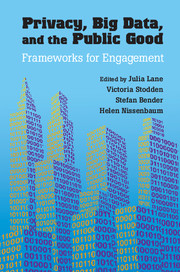Book contents
- Frontmatter
- Dedication
- Contents
- Contributors
- Editors’ Introduction
- Part I Conceptual Framework
- Part II Practical Framework
- 6 The Value of Big Data for Urban Science
- 7 Data for the Public Good: Challenges and Barriers in the Context of Cities
- 8 A European Perspective on Research and Big Data Analysis
- 9 The New Deal on Data: A Framework for Institutional Controls
- 10 Engineered Controls for Dealing with Big Data
- 11 Portable Approaches to Informed Consent and Open Data
- Part III Statistical Framework
- References
9 - The New Deal on Data: A Framework for Institutional Controls
Published online by Cambridge University Press: 05 July 2014
- Frontmatter
- Dedication
- Contents
- Contributors
- Editors’ Introduction
- Part I Conceptual Framework
- Part II Practical Framework
- 6 The Value of Big Data for Urban Science
- 7 Data for the Public Good: Challenges and Barriers in the Context of Cities
- 8 A European Perspective on Research and Big Data Analysis
- 9 The New Deal on Data: A Framework for Institutional Controls
- 10 Engineered Controls for Dealing with Big Data
- 11 Portable Approaches to Informed Consent and Open Data
- Part III Statistical Framework
- References
Summary
Introduction
In order to realize the promise of a Big Data society and to reduce the potential risk to individuals, institutions are updating the operational frameworks which govern the business, legal, and technical dimensions of their internal organizations. In this chapter we outline ways to support the emergence of such a society within the framework of the New Deal on Data, and describe future directions for research and development.
In our view, the traditional control points relied on as part of corporate governance, management oversight, legal compliance, and enterprise architecture must evolve and expand to match operational frameworks for big data. These controls must support and reflect greater user control over personal data, as well as large-scale interoperability for data sharing between and among institutions. The core capabilities of these controls should include responsive rule-based systems governance and fine-grained authorizations for distributed rights management.
The New Realities of Living in a Big Data Society
Building an infrastructure that sustains a healthy, safe, and efficient society is, in part, a scientific and engineering challenge which dates back to the 1800s when the Industrial Revolution spurred rapid urban growth. That growth created new social and environmental problems. The remedy then was to build centralized networks that delivered clean water and safe food, enabled commerce, removed waste, provided energy, facilitated transportation, and offered access to centralized health care, police, and educational services. These networks formed the backbone of society as we know it today.
- Type
- Chapter
- Information
- Privacy, Big Data, and the Public GoodFrameworks for Engagement, pp. 192 - 210Publisher: Cambridge University PressPrint publication year: 2014
References
- 10
- Cited by



